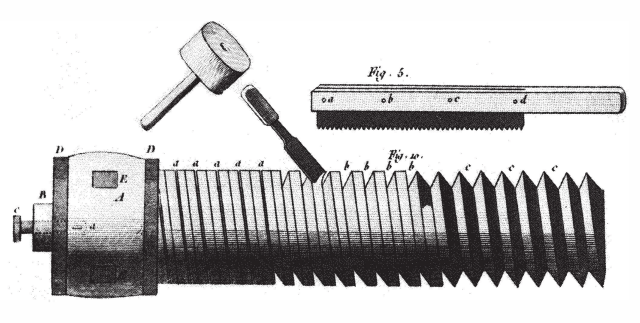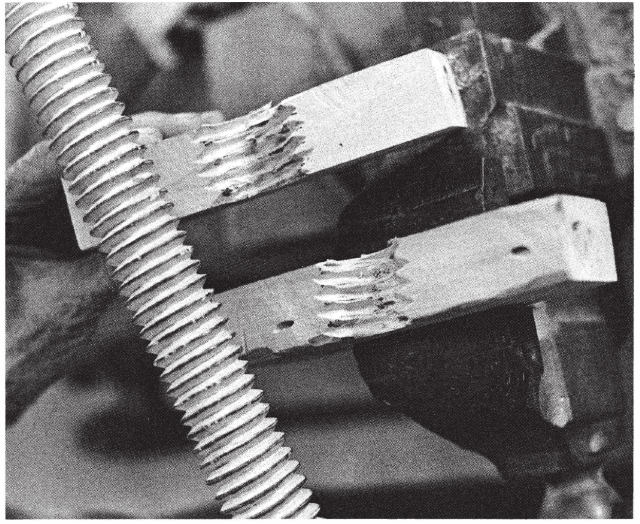
The following is excerpted from “The Workshop Book,” by Scott Landis. First published in 1991, it remains the most complete book about every woodworker’s favorite place: the workshop.
“The Workshop Book” is a richly illustrated guided tour of some of the world’s most inspiring workshops — from garage to basement shops, from mobile to purpose-built shops.
The author traveled all over North America to discover the workshops featured in this book. The result is an intriguing and illuminating look at multiple successful approaches to shop layout.
Without threaded wood or metal screws, the modern woodworking vise wouldn’t exist. Richard Starr, a woodworking teacher and writer in Vermont, has long been fascinated by wooden threads. Here he examines their history and how they’re made.
The first person to make a screw probably did it by hand the way the Eskimos did. Historical photographs suggest the Eskimo’s technique: holding a piece of antler, bone or wood in one hand, they’d twist it past a knife grasped in the other. With the blade at an angle to the shaft, the knife would scribe a helical mark (a spiral) on the material, resulting usually in a left-hand thread because most people are right-handed (try it!). Then, whittling toward the incision, they produced a buttress-shaped thread that could hold a spear tip to its shaft.
That this isolated aboriginal society had threads is a glitch in the history of technology, since most researchers believe every screw on earth had direct ancestors in ancient Greece. Though helices appear in nature and in decorative arts worldwide, we know of no practical application of the shape until the first century B.C. in the land of Plato and Aristotle. The pyramid building Egyptians never thought of it; Chinese machinery did without screws until the 17th century. So if the Eskimos did come up with the idea on their own, they share the pride of invention with a rather sophisticated culture.
By the first century A.D., screws of wood and metal were common in Hellenistic technology. A press for flattening cloth has survived at Herculaneum (covered by Mount Vesuvius’s eruption in 79 A.D. ), its wooden screw in fine condition. At the surgeon’s house in neighboring Pompeii were found dilating instruments (specula) operated by metal screws, as are modern ones. A twin-screw press appears in a wall painting in that doomed city.
How were screws manufactured in antiquity? Fortunately, we had a reporter on the scene: Hero of Alexandria, who lived during the first century A.D. He created several tools of fundamental value, including a basic surveying instrument, but he is best remembered for his simple steam turbine, which was only a toy. An early engineer who wrote broadly about the mechanical technology of his time, Hero described the evolutionary improvement of screw presses used to produce olive oil. Machines identical to the ones he knew survived into the 19th century. He also explained how screws were made in both wood and metal.
Until quite recently, historically speaking, large wooden screws, up to 12 in. or more in diameter, were cut the way Hero described. After laying out a helix on the surface of the cylinder (he used a metal template) you would saw a notch along the mark to the depth of the threads. Then you’d chisel the V shape into the sawkerf. I’ve tried this; it’s easy.
Making the nut was a problem. The earliest method was to use a bare hole with one or more dowels intruding into it to engage the threads. This worked, but lacked strength. Another method was to carve the nut in two halves, then fasten the halves together. This was stronger than the dowel method, but its strength was limited by the integrity of the fastenings, which might have been glue, rivets or bindings of some sort. Besides, fitting the female thread to the male was incredibly tedious. Despite these shortcomings, the practice survives today, as shown in the photo [below].

Finally, Hero described (and possibly invented) a mechanical tap that etched a thread in a hole, working a little like a modern machine lathe. This gadget, shown in the drawing below, remained in use for almost 2,000 years until hydraulic presses made the wooden machinery obsolete.
In Hero’s time, if you needed a small-diameter metal screw, you’d probably cut it with a file and use the dowel-in-the hole method for the nut. It was also possible to cast a nut around an accurately filed screw. The worm drive, where a male screw engages a gear rather than a nut, is said to have been developed by Archimedes in the third century B.C.
Blacksmiths had a technique where inside and outside threads were made at the same time. First the smith would forge a ribbon of iron, square in section, and fold it back on itself, then he would wrap the doubled strip around a metal rod. Sliding the rod out, he’d separate the pair of helices, then solder one to the rod, the other inside a hole. Large screws for presses or vises were made this way and jewelers could use the method on tiny work.
Threading taps for metal and wood, similar to the design common today, were described by da Vinci in the 16th century and probably were in use much earlier. Usually these amounted to notches filed on the corners of a square rod, very simple to make but capable of cutting a decent thread.

Dies, the female-threaded devices designed to cut male screws, are probably as old as the metal-cutting tap needed to make one. Screw boxes, the wood-cutting equivalents of the die, used a V-gouge cutter positioned against a nut. I imagine this tool to be very old, although I doubt they existed in antiquity or Hero would have described them. Da Vinci sketched a tool that may or may not be a screw box; if it is, it’s the earliest representation I’ve been able to find. The 18th-century screw box and tap are almost identical to those available today. Several devices are now available that use a router to cut screws in wood very neatly.
After Hero’s wood-threading tap it was probably twelve or fourteen hundred years before people resumed the search for new methods of cutting screws quickly and accurately. Most methods were adaptions of the lathe, a tool that had been in worldwide use for thousands of years. The challenge of threading and, later, of turning screw-like ornamental shapes, stretched mankind’s ingenuity and eventually evolved into the machine-tool industry upon which our modern technology is based. As woodworkers we owe a nod to the early inventors who made possible our labor-saving machinery. And when we cut a screw in wood for a child’s toy or a workbench vise we are a lot closer to our roots than we may think.
/*<![CDATA[*/
(function () {
var scriptURL = 'https://sdks.shopifycdn.com/buy-button/latest/buy-button-storefront.min.js';
if (window.ShopifyBuy) {
if (window.ShopifyBuy.UI) {
ShopifyBuyInit();
} else {
loadScript();
}
} else {
loadScript();
}
function loadScript() {
var script = document.createElement('script');
script.async = true;
script.src = scriptURL;
(document.getElementsByTagName('head')[0] || document.getElementsByTagName('body')[0]).appendChild(script);
script.onload = ShopifyBuyInit;
}
function ShopifyBuyInit() {
var client = ShopifyBuy.buildClient({
domain: 'lost-art-press-test.myshopify.com',
storefrontAccessToken: 'f83226aac752f3a8e262f8a8273c9739',
});
ShopifyBuy.UI.onReady(client).then(function (ui) {
ui.createComponent('product', {
id: '6581551726655',
node: document.getElementById('product-component-1660578243444'),
moneyFormat: '%24%7B%7Bamount%7D%7D',
options: {
"product": {
"styles": {
"product": {
"@media (min-width: 601px)": {
"max-width": "calc(25% – 20px)",
"margin-left": "20px",
"margin-bottom": "50px"
}
},
"button": {
"font-size": "14px",
"padding-top": "15px",
"padding-bottom": "15px",
"border-radius": "11px",
"padding-left": "22px",
"padding-right": "22px"
},
"quantityInput": {
"font-size": "14px",
"padding-top": "15px",
"padding-bottom": "15px"
}
},
"text": {
"button": "Add to cart"
}
},
"productSet": {
"styles": {
"products": {
"@media (min-width: 601px)": {
"margin-left": "-20px"
}
}
}
},
"modalProduct": {
"contents": {
"img": false,
"imgWithCarousel": true,
"button": false,
"buttonWithQuantity": true
},
"styles": {
"product": {
"@media (min-width: 601px)": {
"max-width": "100%",
"margin-left": "0px",
"margin-bottom": "0px"
}
},
"button": {
"font-size": "14px",
"padding-top": "15px",
"padding-bottom": "15px",
"border-radius": "11px",
"padding-left": "22px",
"padding-right": "22px"
},
"quantityInput": {
"font-size": "14px",
"padding-top": "15px",
"padding-bottom": "15px"
}
},
"text": {
"button": "Add to cart"
}
},
"option": {},
"cart": {
"styles": {
"button": {
"font-size": "14px",
"padding-top": "15px",
"padding-bottom": "15px",
"border-radius": "11px"
}
},
"text": {
"total": "Subtotal",
"button": "Checkout"
}
},
"toggle": {
"styles": {
"count": {
"font-size": "14px"
}
}
}
},
});
});
}
})();
/*]]>*/